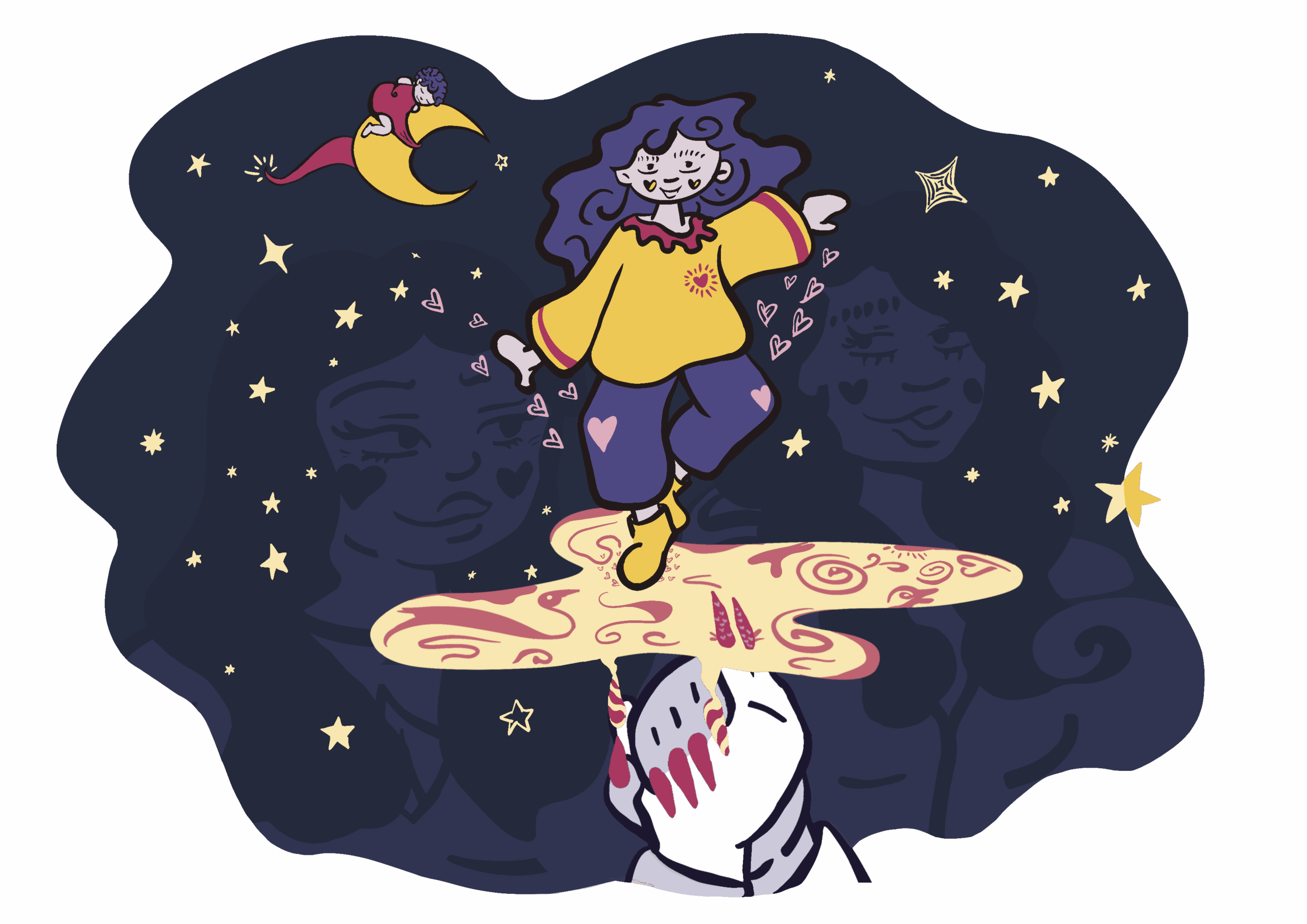
On a bus, inside the pocket of a thick winter coat, a little bottle of estrogen is cradled in the palm of a hand. Fingers wrap tightly around the vial: 50 ml of enanthate with castor oil. “Hormone replacement therapy,” they like to call it when they lock it away. In other words – magic!
Fifty milliliters of magic, acquired in a park. They hold transformative potential. She who will receive the vial is not considered “woman enough” by immigration authorities, healthcare professionals, or the state to pick it up at a pharmacy. Instead, the hand of a friend will bring it to her.
Sharing is caring, and caring is survival. We care for each other from before we’re born until after we’re dead. On The Mutual Aid Podcast, the lawyer and political organizer Dean Spade speaks of the longstanding tradition of Jewish burial societies who perform the tahara—a ritual during which the body of a deceased person is washed, dressed, and spiritually prepared for burial. He explains that, in the US, it may be volunteer groups who perform these ancient practices of care, especially for Jews who have been excluded from congregations on the basis of their identities or beliefs. These volunteer groups ensure that many trans, queer, and anti-Zionist Jews have access to traditional spiritual practices, ensuring that their bodies are respected and treated with dignity and care in death.
Where there is death, there is life — and all that comes with it. For many queer people, especially trans women of colour, growing old remains a privilege. Queer people endure a higher risk of violence and live in proximity to death. Yet, reducing them to these (potential) experiences denies them their full humanity. The lives of queer people cannot be reduced to their bodies or the misogynistic culture wars that are waged on them — even when they use their bodies to engage in sex work.
The 2023 film The Stroll, co-directed by former sex-worker Kristen Lovell, traces the stories of Black and Latina trans sex workers in New York’s Meatpacking District during the 1980s and 1990s. Her narrative captures the humanity of the trans women and sex workers who’ve passed, who have been murdered, and those who’ve survived. She highlights elements of joy and community that tend to be written out of these stories. Thereby, The Stroll goes beyond a stereotypical depiction of sex work and survival as “dark and gritty”.
In the film, women recall their superhero alter egos, that would come out in moments of danger – from battle bot, to Wonder Woman, to Buffy the Vampire Slayer – “You know, you wasn’t going to take my money. You wasn’t going to beat me up. I was going to get you before you got me.” They describe the mentorship they received from others while working the strip, and they remember nights spent on the piers down on Christopher Street. There, activist Sylvia Rivera’s makeshift encampment provided a safe space for those with nowhere else to go. They all knew the risk of being attacked or even killed and banded together to protect and support one another, resist and fend off violence from police, clients, passers-by, and state repression.
However, such mutual protection and solidarity do not seem typical of those grouped under the rainbow or queer umbrella today. Instead, we see a “happy inclusion” framework of sexual citizenship culminating in an LGBT+ necropolis. In this city of the dead, the language of revolution and resistance masks and enables systemic violence, exploitation, and neglect both on local and global scales. It’s a pinkwashed Pride celebration that has given up on fighting for common dignity in life and death for the illusion of inclusion. Conditional rights are granted to those whose deviance and immorality can be hidden behind an image of normalcy. Those who don’t want to or cannot abide by prescribed social norms are excluded, abjected, or reformed – they become so-called surplus populations. To simultaneously maintain the military-industrial complex and an image of progress, we see companies, armies, and nations draping themselves in rainbow colours. The neoliberal state now consults LGBT+ experts when asking, “Who must die so that we can live?” Or in the words of the author of Queer Lovers and Hateful Others, Jin Haritaworn, “Who must live so that they can die with impunity?”
These dynamics, through which LGBT+ rights are incorporated into death-making nationalist, imperialist, and racist agendas, are what the academic and author Jasbir Puar has termed homonationalism in her book Terrorist Assemblages. In this context of population control and death-making, homonormativity and assimilation to heteronormative societal standards represent a trap, in which stigma is reproduced and projected. That is not to say that an LGBT+ person may not wish, truly and genuinely, to live according to the hegemonic societal model. Rather, it reveals that the rights, autonomy, and humanity of the LGBT+ citizen are conditional and become dependent on successfully and perpetually performing respectability, innocence, and morality. Failure to do so invites dehumanisation, oppression, and condescension.
In contrast to rights-bearing citizens, inhabitants of the margins are portrayed as deviant, poor, and dysfunctional. As surplus populations, they may be portrayed as victims needing salvation and assistance, or as backwards people, incapable of making their own decisions. Either way, they are stripped of their agency and bodily autonomy and reduced to stigmatized identities. For example, sex workers are often deprived of being considered as multifaceted people with interests, feelings, and ambitions, within and beyond their professions. Rather than being called friends, lovers, experts, parents, siblings, or caregivers, they will be judged, criminalised, victimised, and categorised as prostitutes, drug addicts, and abusers. Stigma overwrites their aspirations and interests while defining and limiting their access to dignified living conditions – for example, in terms of support, housing, employment, healthcare, or education.
The pervasive stigmatisation of sex workers, especially in relation to parenthood and caregiving, is challenged in the children’s book How Mamas Love Their Babies. The authors, Juniper Fitzgerald and Elise Peterson, visually and textually represent different ways in which mothers may care for their babies. Collages illustrate their words: “Some mamas stay home with their babies all day long [..] Some mamas do other kinds of work to care for their babies. They use their bodies in different ways [..] It’s hard work!”. These words may affect how we view the work of activists such as Sylvia Rivera.
“We fucking fed, we fed children. We took care of children,” Sylvia Rivera’s voice shakes as she speaks. She’s talking about the house on 213 East Second Street in which STAR operated a shelter and social space for trans and unhoused LGBT+ youth in the early 1970s. STAR – Street Transvestite Action Revolutionaries – was founded by Sylvia Rivera and Marsha P. Johnson in 1970 to focus on gender self-determination and the needs of homeless queer youth, many of whom did sex work. Barely older than those they were supporting, the queens running the STAR house kept the building going and worked the streets to make money. “We paid the rent. We didn’t want the kids out in the streets hustling. We already went through it. We wanted to show them that there was a better life.” The creation of the STAR house and the work of the queens running it, questions how we view parenthood and care-giving. Who gets to be a parent or caregiver? Who gets to choose parenthood or renounce it? What are the implications for both caregivers and children? Who listens to the voices and thoughts of children? Who answers their questions, needs, and concerns?
STAR created and sustained life and joy for queer youth in a topography of destruction, surveillance, brutal policing, and deprivation of state resources. The STAR house was the first LGBT+ youth shelter in North America, the first trans women of colour-led organization in the US, and the first trans sex worker labour organization. It is through a commitment to survival, transformation, and healing that STAR was able to provide pockets of safety and care to those most marginalised, who they refused to abandon. The queens running STAR were able to, in the words of Nobel Prize-winning writer Toni Morrison, “stand at the edge and claim it as central… And to let the rest of the world move over to where they were.”
This invitation for the world to move remains pertinent today, as sex workers are still depicted as inherently dangerous individuals who put children at risk from a sociolegal and moral standpoint. There is a greater risk of child apprehension from sex working parents whose profession can be used against them in custody battles. As a result, sex-working parents are thus likely to go to extremes to conceal their professions and maintain custody. But what about the countless sex workers like Sylvia Rivera, who devoted their lives to supporting and taking care of queer youth? Why were these kids on the street in the first place? The moral pedestal is a comfortable place to speak from, but who were these kids running away from and seeking safety from? Why is this still the case for a lot of queer youth today? Susy Shock’s lullaby Canciones de Cuna para Niñxs Diversxs might give us some guidance.
Susy Shock has said that the song is about building a world that harbours hope for the trans children growing up after us. We hold a collective responsibility so that today’s children, and those who will be born in the future, can be free to express themselves and to make their own decisions. The lullaby begins: “Esta noche no tengo miedo,” I do not feel fear tonight. Trans people and sex workers of colour have persistently faced the fears of society in the struggle for non-negotiable human rights and change despite being consistently left behind by the mainstream LGBT+ movements. Over and over, it is thanks to their commitment to fighting for all of us that we were able to move forward.
And maybe we owe it to trans sex workers, and to our children, to put aside our own fears and projections and to listen. To learn from the knowledge and experiences of those who’ve preceded us, to take them seriously, and to support their self-determination. The community organiser and godmother of the Black Lives Matter movement, Ceyenne Doroshow, underlines this: “You owe it to every trans woman before you, and everyone after you, to keep moving and keep pushing. […] and it is important that we all get an opportunity to thrive.” Building a world of hope and dignity for all of our children requires that we engage in a solidarity that seeks true equity, coalition, survival, and healing. Assimilation into a status quo that expects us to betray one another in order to move forward will only perpetuate the stigma. There is something to be said about the mechanisms of power and relationality.
And so, the little vial of magic that has made it from the bus to its rightful owner. She now wraps her own fingers around the vial, will transform her body. Surrounded by a community that cares for her. She begins to be born again.
“Esta noche no tengo miedo. Ay que se escriba ese cuento, bien grande, bien tibio. Ay, que nos arme un paisaje de un mundo más digno. Chiquito, Chiquita. Chiquito, Chiquita.”
“I do not feel fear tonight. There should be that other story, oh so vast and oh so warm. It should lay out for us the landscape of a more dignified world. Chiquito, Chiquita. Chiquito, Chiquita.”




